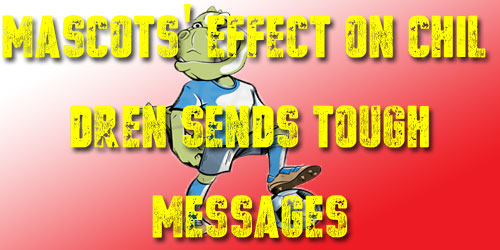 17 March 19
17 March 19
Mascots' Effect On Children Sends Tough Messages
Youngsters and Mascot Mental Images
Mascots hold a solid mental image for most people that come in touch with one. But mascots impact on children is much stronger and profound than with any other age group. Kids often behave with fondness to mascots that show positive characteristics. A child may be delighted by the way a mascot dances or any funny physical action the mascot partcipates in. This is also true in case a mascot is the embodiment of a product that a kid wants his or her parents to buy for them. Families are often susceptible to the marketing marketplace. This is accurate since many products such as gadgets, games, and foods are ordered by parents on behalf of their children. Children may be very persistent in ensuring that their parents choose the hottest cereal or plaything because a mascot said it had been great. Furthermore, children that are not however literate may definitely gravitate towards a mascot. Children at this stage of development look for pictures or symbols that signify familiar what to them.
Mascots as Solid Symbols
Children may be the most sensitive of most age ranges to mascots and their symbology. An adult might be able to discern if a product or graphic that a mascot is portraying is worthless, while a child could see something completely different. Before language skills are strongly produced, children have a tendency to remember events and folks in snapshots like photographs in their stories. Mascot Design Cost may be able to grab a place in the child's mind which will be vivid and keep meaning into adulthood for the child.
Good Vibrations
The positive emotions that mascots elicit from young children are often associated with just what a mascot does and not simply something itself. In the case of sporting clubs the mascots impact on children may be to excite or enthuse them about the team or perhaps a game taking place. Not to mention once again, kids may be attracted to the mascot on an individual level. Instead of wanting something lauded by way of a mascot, children may want something that signifies the mascot like a: stuffed dog, shirt, pennant flag, or pin. Mascots in of themselves can be easily advertised to children to market team sales. Furthermore, the mascot may encourage a new era of fans being realized because of the team.
Mascots, Universities, and Self-Image
Elementary schools up to university campuses heavily use mascots to mention team photo and assist in promoting team nature. Mascots effect on children may be very strong when coping with school mascots. Kids face the image normally on a daily basis. The institution mascot may be present in the schools' outside sign or on the wall or floors of the fitness center. Also, young children who play sports activities may dress in uniforms which have the mascots proudly put upon them. Young children may come to see themselves as getting many of the same characteristics as the mascot should they participate in team sports. This is why mascots that market a positive graphic are very important for school aged young children. Negative mascots impact on children may advertise negative pictures of the school or perhaps also impact a child's self-image.
Responsible Rendering of Mascots
Since mascots effect on children is significantly profound adults have got a responsibility to generate mascots that distribute a warm and positive message. They have to keep the ideal interest of kids in mind when making the costume with the mascot. Also, what of the Mascot Character Design have become important. The individual portraying the mascot comes with an obligation to do something fun and upbeat, without participating in any behavior that could have a poor or damaging connotation. This will only help paint the group or item in a confident light with not only children, but men and women as well.


Comments